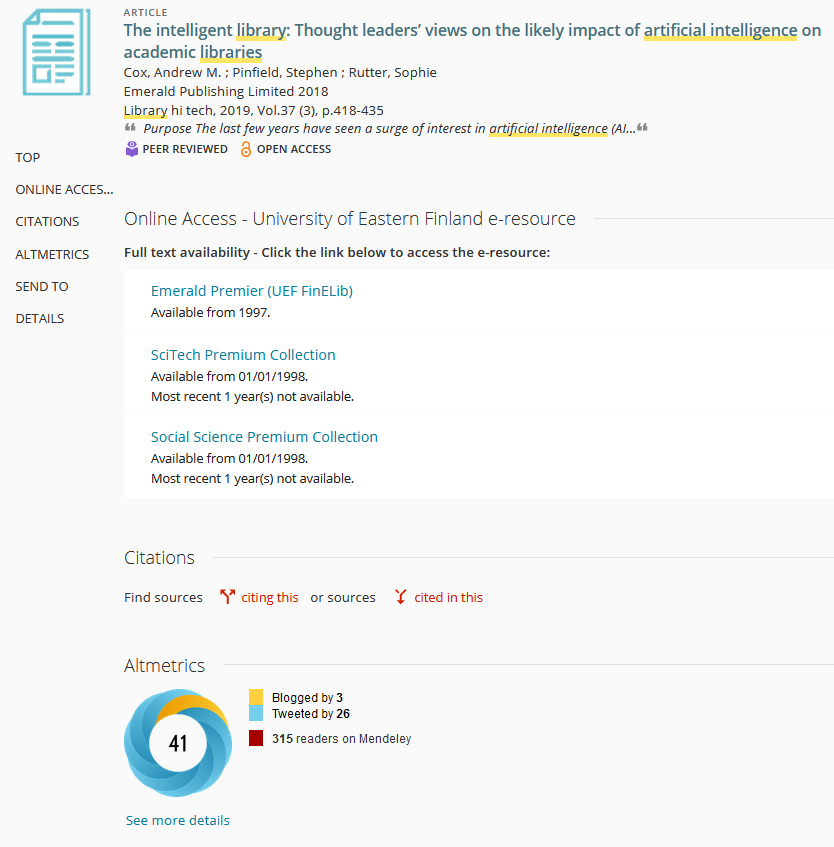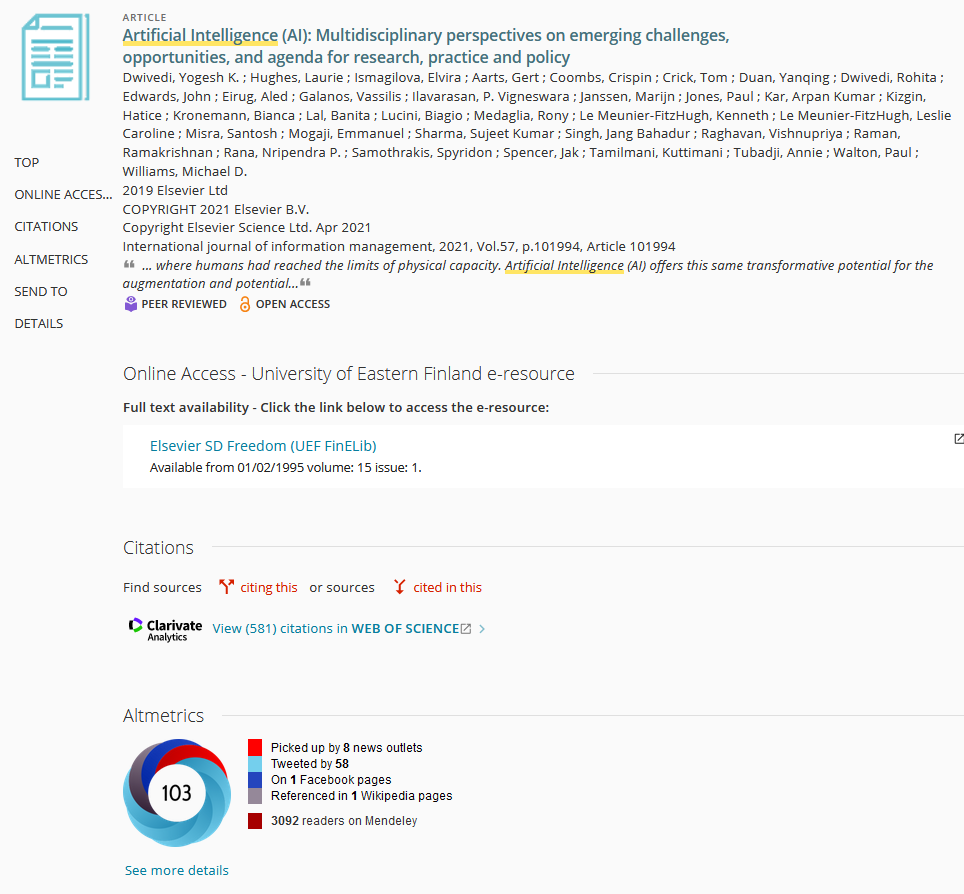Research and researcher visibility, networking and altmetrics
It is important for researchers that their scholarly publications gain visibility. In addition to OA publishing, researchers can enhance the visibility and accessibility of their publications through forums that are used extensively. Researcher visibility involves managing information about researchers and their work in order to raise researchers’ and organisations’ profiles and to promote the visibility of their research.
Researchers’ personal methods to improve the findability and visibility of their publications include, for example, using ORCID identifier, publishing open access via OA and hybrid journals or by self-archiving, and participating in social networking services of their own field.
UEF has a service called UEF Connect for researchers and research groups to offer an opportunity to showcase their expertise and research activities. A page has been reserved for all university researchers and other experts (at the moment with staff status) where they can update their information. The address can then be linked to funding applications and used for other similar purposes. It also offers an arena for research groups to introduce themselves.
Read more about UEF Connect. If possible, log in with your personal UEF credentials to complete your information. Instructions (also in Finnish).
Networking and altmetrics
Academic social networks support activities across the research cycle, from getting job suggestions, sharing and reading full-text papers to following use of your research output within the system (i.e. altmetrics).
Traditional metrics has focused on the impact of research within academia. However, research impact is much more than that. When measuring societal impact, the focus is on the contribution research makes to society. So, research impact can be defined as the contribution that research makes to the society, economy, environment or culture. New metrics can include altmetrics, but also e.g. data citation and patent metrics. Read through What types of impact are there? to better understand what kinds of research impact exist.
Peer-reviewed journals and conferences have traditionally been the focus of researchers’ efforts to make their research visible. However, as social media has become more prevalent, the way academics disseminate their research is changing. Academics are increasingly using social media and are expected to have a professional online presence.
In the last decade there has been an emergence of Academic Social Networking Sites (ASNSs). Each site offers its own combination of tools and capabilities to support research activities, communication, collaboration, and networking. However, due to their variety, it might be challenging for academics to evaluate and use them. Also maintaining multiple profiles might be time-consuming. Thus, during this course, we hope you can find a social network site / sites suitable for your needs.
Traditional measurements of academic success, such as citation counts, journal impact factor or author h-index (i.e. bibliometric indicators, see 5. Module), might no longer be sufficient to estimate research impact, and the social importance of authors is becoming increasingly significant. Altmetrics (i.e. alternative metrics) measures a publication’s online visibility by the numbers of, for instance, clicks, downloads, blog posts, bookmarks, likes and tweets. Since most research, including journal articles, are now electronic and networked we can track how many times they are accessed, used, and shared. Altmetrics are meant to compliment, not totally replace, the traditional measures to give a more complete picture of how research and scholarship is used.
Altmetrics can answer questions such as:
- How many times was my article downloaded?
- Who is reading my work?
- Was it covered by any news agencies?
- Are other researchers commenting on it?
- How many times was it shared or liked? (on Facebook, X (ex-Twitter), etc.)
Altmetrics data accumulate at a faster speed compared to traditional metrics. In disciplines where citations grow slowly, or in the context of new researchers, this speed helps determine which outputs are gaining online attention. Although altmetrics are often thought of as metrics about articles, they can be applied to people, journals, books, data sets, presentations, videos, source code repositories, web pages, etc. Altmetrics generally offer a faster and wider-ranging measures of how people are discussing and using your work.
Altmetrics can point researchers to interesting and more valuable research that has received most attention from other researchers and from the general public. Also, altmetrics can inform funders, policymakers and other stakeholders of the wider impact of research and give a more nuanced understanding of the impact research has made.
Read more about almetrics and see the strengths and weaknesses of it.
Altmetric follows this situation using your output, e.g. article, book, presentation, report, and your identifier, like DOI, ORCID, PubMedID, URN, and mentions in followed online sources.
Altmetric’s interface tracks online engagement to reveal how and where your research is making a difference. They follow online engagement using your output, e.g. article, book, presentation, report, and your identifier, like DOI, ORCID, PubMedID, URN, and mentions in a range of online sources. Following the talk about your research is crucial in our online world and plays an important role in its further impact. You can track this information as soon as you publish instead of waiting for citations. The Altmetric badge or donut shows you in which services your research has been noticed and how much attention it has received. The data is collected from a versatility of documents and services. The Altmetric badge appears on many publishers’ pages, search services, such as UEF Primo, organisations’ electronic repositories, such as UEF eRepo, and also on individual researchers’ websites. The idea is to follow the attention and the impact.
You can add the Altmetric it! bookmark on your browser and also use many other tools free of charge. The service also has chargeable tools for researchers and organisations.
Watch A beginner’s guide to altmetrics. 2 min 59 sec. Published on May 5, 2016. CC-BY. Illustrations courtesy of Jean Liu (@jean_draws). Icons courtesy of Noun Project and Michal Waclaw Kulesza
Use UEF Primo to search for international articles in your field and check their Altmetric score. Click See more details to find out what kind of media attention the articles have received. Two examples:


Academic social networking and visibility services
There are several social networking and visibility platforms for academics. Acquaint yourself with at least one of these.
More information about research and researcher visibility can be found on UEF Library web pages.
Further information:
(links open in new tabs)
J. Priem, D. Taraborelli, P. Groth, C. Neylon (2010), Altmetrics : A manifesto, 26 October 2010.
Davies, S. & Horst, M. 2016. Science communication: culture, identity and citizenship. London, Palgrave Macmillan.
Goldstein, S. 2019. Academic Social Networking Sites are Smaller, Denser Networks Conducive to Formal Identity Management, Whereas Academic Twitter is Larger, More Diffuse, and Affords More Space for Novel Connections. Evidence Based Library and Information Practice, 15(1).
Huang W, Wang P, Wu Q (2018) A correlation comparison between Altmetric Attention Scores and citations for six PLOS journals. PLoS ONE 13(4): e0194962. https://doi.org/10.1371/journal.pone.0194962
Measuring Research Impact: 10 Ways To Boost Your Impact. A guide to measuring the impact of your research by University of Waikato
PLOS Altmetrics Curated Collection
Societal Impact Toolkit – to help you understand how other researchers view societal impact and how they’ve been successful in creating it. Springer Nature.
Thenwall, M. (2020) The Pros and Cons of the Use of Altmetrics in Research Assessment. Scholarly Assessment Reports 2(1): 2.
UEF training recordings related to research communication and visibility (UEF Heimo, sign in with your UEF account)
What are altmetrics? Video (3:45) by University of Houston Libraries
(8/2023 KH; 8/2024/TO)
< Previous page: Researcher IDs
Next page: Responsible sharing in scholarly networks >

